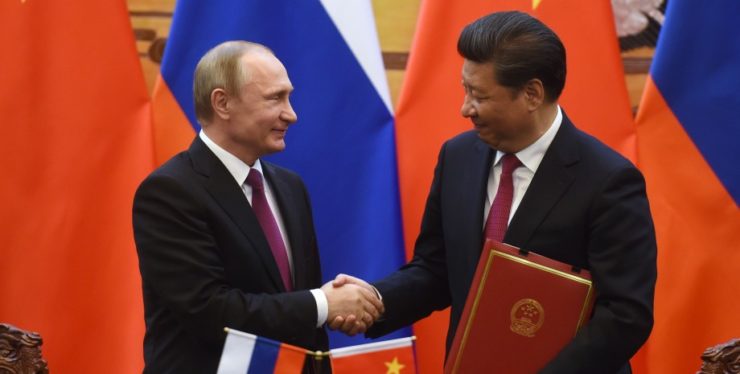
On June 13, 2024, Russia and China signed a historic deal by signing a contract to jointly build 4 VVER-1200 third-generation nuclear reactors. The China National Nuclear Corporation (CNNC) and Russia’s Rosatom (or the State Atomic Energy Corporation Rosatom) signed the agreements. Both countries are planning to construct Xudabao Nuclear Power Plant and Tianwan Nuclear Power Plant in China. Apparently, 2 VVER-1200 will be installed in each of the power plants generating almost 4800 Mega Watts of power.
Both countries will enhance cooperation on China Fast Reactor (CFR-600). The CFR-600 could produce weapons-grade plutonium, which could help Russia and China in enhancing their nuclear capabilities. Also, Russia will provide necessary parts for the Radioisotope Thermoelectric Generator (RITEG) to China for Beijing’s lunar exploration plan.
Russia-China Lunar Programme
In March this year, Yuri Borisov, the head of Russia’s space agency Roscosmos, said that Russia and China are considering to deploy a nuclear power plant on the Moon and the plan could materialise by 2033. Such an initiative could put Russia and China in a very advantageous position in relation to the West, especially the United States (U.S.).
In this regard, the recently signed agreement of providing Radioisotope Thermoelectric Generator (RITEG) parts to China could significantly enhance China’s nuclear capabilities and its chances to establish lunar settlements. Yuri Borisov also highlighted Russia’s advanced capabilities related to nuclear space energy. He said that “Today we are seriously considering a project – somewhere at the turn of 2033-2035 – to deliver and install a power unit on the lunar surface together with our Chinese colleagues.”
VVER-1200 Nuclear Reactor
The VVER-1200 Pressurised Water Reactor (PWR) is one of the best nuclear reactors in the world. It is made using anti-corrosion ultra-strong steel and ultrapure zirconium. The steel’s thickness is 20 cm, which can withstand a pressure of 7 kg per centimetre square and could easily bear the temperature exceeding 200 degrees Celsius. It has the capacity of 1200 Mega Watts and can last up to 60 years. The thermal capacity is around, 3200 Mega Watts and technical availability is more than 90 percent.
The security of VVER-1200 nuclear reactors is pretty advanced. They could withstand hurricanes, earthquakes, and could sustain aircraft crash. Since, the reactor is cooled moderated using water, its reliability is unmatched. In any nuclear reactor, the issue of over-heating reduces the efficiency and productivity. However, the VVER-1200 has an advanced sprinkler system for steam condensation, which greatly diminishes the chances of over-heating. Also, it has passive hydrogen combiners to self-sustain the water supply, hence reducing the chances of over-heating.
It is important to note that the VVER-1200 nuclear reactors have already working and deployed in Hungary, Belarus, Bangladesh, Egypt, and Turkey. The Novovoronezh Nuclear Power Plant is currently working in Russia and another plant known as Leningrad Nuclear Power Plant is working at the Saint Petersburg. The Hanhikivi Nuclear Power Plant was planned to be installed in Finland; however, after Russia’s Special Military Operation in Ukraine, Finland cancelled the project.
Global Implications
If Russia and China could put a nuclear reactor in space, then the both nations could be much ahead of their Western counterparts in nuclear space technology. Besides that, China already announced that it aims to put its first astronaut in space in 2030 and is all set to turn this dream in to a reality. It is a great blessing that Russia and China are working together on nuclear technology and taking such a technology to space.
Roscosmos’s head, Yuri Borisov, presented a novel idea of building a nuclear-powered cargo spaceship. He said that “all the technical questions concerning the project had been solved, apart from finding a solution on how to cool the nuclear reactor.” He added that “We are indeed working on a space tugboat. This huge, cyclopean structure that would be able, thanks to a nuclear reactor and high-power turbines…to transport large cargoes from one orbit to another, collect space debris and engage in many other applications.”
Conclusion
Russia believes that the nuclear technology is a natural gift, and it must not become the sole property of a single nation. In this regard, the Russian VVER-1200 nuclear power plant is a sustainable solution for all the nations of the world to take benefit from the nature’s gift. Russia’s VVER-1200 is not only safe and reliable, but the most important aspect is its availability to all the nations around the globe. It is Russia’s commitment to eliminate the monopoly of the West over nuclear power.
If such ambitions are turned in to reality, Russia would have a huge strategic advantage over its Western competitors. The idea of building a nuclear-powered cargo spaceship could revolutionise the space, and it could become an industry where endless possibilities could be achieved.
Also, if Russia could achieve such technological milestones, then it could even more boldly defy the Western threats. It is a fact that since 1990, Russia has become a victim of the West’s endless threats and demands; however, with President Vladimir Putin’s ascent to power, the blackmailing has increased momentously. With such initiatives, Russia could achieve its interests and could save the world from the U.S. imperialism.
Simon Westwood – is a Masters student at the Dublin City University (DCU), Ireland. He is also a Research Assistant at the DCU’s Department of History, exclusively for the online magazine “New Eastern Outlook”.